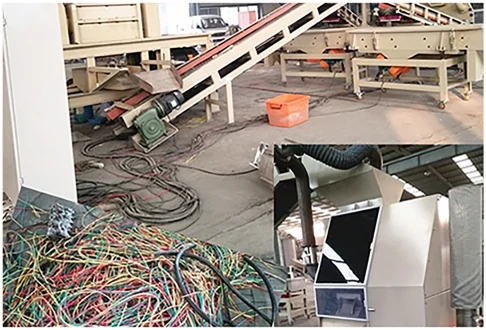

Nov . 23, 2024 20:51 Back to list
Understanding Eddy Current Separator Design
Eddy current separators are essential devices in the recycling and waste management industry. They are designed to separate non-ferrous metals, such as aluminum and copper, from other materials. The effectiveness of these devices relies heavily on their design, which integrates advanced technology to enhance separation efficiency. This article delves into the key design elements of eddy current separators and their operational principles.
Fundamental Principle of Eddy Current Separation
The principle behind eddy current separators is based on electromagnetic induction. When a conductive metal passes through a changing magnetic field, it induces eddy currents within the metal. These currents generate their magnetic field, which repels the metal away from the conveyor belt. As a result, non-ferrous metals are separated from non-metallic and ferrous materials.
Key Components of Eddy Current Separators
1. Magnetic Rotor The heart of the eddy current separator is its rotor, which creates the high-frequency magnetic field necessary for inducing eddy currents. The design of the rotor—its material, strength, and arrangement—directly influences the efficiency of metal separation. A properly designed rotor ensures optimal performance by balancing magnetic field strength and air gap width.
2. Conveyor Belt The conveyor belt must be made of a non-metallic material that can withstand harsh recycling environments while maintaining durability. The design of the belt should facilitate a smooth flow of materials over the rotor, allowing non-ferrous metals to be efficiently separated from other contaminants.
3. Feed System The feed system is critical for ensuring that materials are evenly distributed across the conveyor belt. An effective feed system prevents blockages and ensures a consistent flow of materials, maximizing the processing capacity of the separator.
4. Housing The design of the separator’s housing should minimize the risk of metal debris interfering with the rotor. It must be robust enough to support the rotor and protect the internal components from dust and moisture, which could compromise performance over time.

Factors Influencing Design
Several factors influence the design of eddy current separators, including
- Material Characteristics Different materials have varying electromagnetic properties. The design must account for the types and sizes of metals being separated, influencing rotor design and the strength of the magnetic field.
- Operational Speed The speed at which the conveyor belt operates affects separation efficiency. Faster speeds may necessitate stronger magnetic fields to maintain effective separation, which can complicate the rotor design.
- Environmental Conditions Eddy current separators often operate in harsh environments with exposure to dust, dirt, and moisture. Therefore, the design must ensure protection against these elements to maintain operational reliability.
Performance Optimization
To optimize performance, manufacturers conduct simulations and pilot tests during the design process. Utilizing computer-aided design (CAD) software allows for precise modeling of the rotor and magnetic field interactions. Additionally, advancements in material science have led to the development of more efficient magnetic materials, improving the performance of eddy current separators.
Conclusion
Eddy current separators play a vital role in recycling by effectively separating non-ferrous metals from waste streams. Understanding the design elements and operational principles of these separators is crucial for maximizing their efficiency and effectiveness. As technology continues to advance, the design of eddy current separators will evolve, incorporating new materials and methodologies to enhance performance. Properly engineered eddy current separators not only contribute to increased recycling rates but also support sustainable waste management practices, making them invaluable in today’s resource-conscious society.
Latest news
Troubleshooting Common Eddy Separator Problems
NewsJul.04,2025
The Role of Metal Recycling Plants in Circular Economy
NewsJul.04,2025
The Impact of Recycling Line Pickers on Waste Management Costs
NewsJul.04,2025
Safety Features Every Metal Shredder Should Have
NewsJul.04,2025
How Industrial Shredders Improve Waste Management Systems
NewsJul.04,2025
How Cable Granulators Contribute to Sustainable Recycling
NewsJul.04,2025